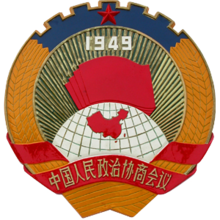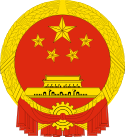- Chinese People's Political Consultative Conference
-
Chinese People's Political Consultative Conference 
Simplified Chinese 中国人民政治协商会议 Traditional Chinese 中國人民政治協商會議 Transcriptions Mandarin - Hanyu Pinyin Zhōngguó Rénmín Zhèngzhì Xiéshāng Huìyì People's Republic of China 
This article is part of the series:
Politics and government of
the People's Republic of ChinaIdeology- Leadership of China
- Constitutional history
- National People's Congress
- NPC Standing Committee
- President: Hu Jintao
- State Council (Central People's Government)
- Premier: Wen Jiabao
- Vice Premiers
- 1st ranking: Li Keqiang
- State Councilors
- Vice Premiers
- Premier: Wen Jiabao
- PRC Central Military Commission
- Supreme People's Court
- President: Wang Shengjun
- Supreme People's Procuratorate
- Procurator-General: Cao Jianming
- Political Consultative Conference
- National Committee
- Minor political parties
Other issues
The Chinese People's Political Consultative Conference [
 Listen (help·info)], shortened as 人民政协, Rénmín Zhèngxié, i.e. "People's PCC"; or just 政协, Zhèngxié, i.e. "The PCC"), abbreviated CPPCC, is a political advisory body in the People's Republic of China. The organization consists of delegates from a range of political parties and organizations, as well as independent members, in China. The proportion of representation of the various parties is determined by established convention, negotiated between the parties.
Listen (help·info)], shortened as 人民政协, Rénmín Zhèngxié, i.e. "People's PCC"; or just 政协, Zhèngxié, i.e. "The PCC"), abbreviated CPPCC, is a political advisory body in the People's Republic of China. The organization consists of delegates from a range of political parties and organizations, as well as independent members, in China. The proportion of representation of the various parties is determined by established convention, negotiated between the parties.In practice, the largest and dominant party in the Conference is the Communist Party of China. Other members are drawn from the United Front parties allied with the CPC, and from independent members who are not members of any party. The Conference is, to a large degree, controlled by the Communist Party[citation needed], but it is intended to appear to be more representative and be composed of a broader range of people than is typical of government office in the People's Republic of China[citation needed].
The National Committee of the Chinese People's Political Consultative Conference (中国人民政治协商会议全国委员会, Zhōngguó Rénmín Zhèngzhì Xiéshāng Huìyì Quanguo Weiyuanhui, shortened as 全国政协, Quánguó Zhèngxié, i.e. "National PCC") typically holds a yearly meeting at the same time as plenary sessions of the National People's Congress (NPC). Both CPPCC and NPC plenary sessions are often called the Lianghui (The Two Meetings), making important national level political decisions.
A less common translation is "the National Congress". This translation is discouraged, as it causes confusion with the National People's Congress as well as with the National Congress of the Communist Party of China.
The organizational hierarchy of the CPPCC includes the National Committee and regional committees. Regional committees of the CPPCC include the provincial, prefecture, and county level. According to Article 19, Section 2 of the Charter of the Chinese People’s Political Consultative Conference, the relationship between the National Committee and the regional committees is a relationship of guidance (no direct leadership). So are the relationships between upper-level regional committees and lower-level committees. Operating budgets on each level are independently administered by the financial administrations for the region, making the National committee and all regional committees separate individual entities. An indirect leadership, however, exists via the United Front Departments on each level.
Contents
History
The Conference dated prior to the existence of People's Republic of China. During negotiations between the Communist Party of China and the Kuomintang in 1945, the two parties agreed to open multiparty talks on post-World War II political reforms via a Political Consultative Conference. This was included in the Double Ten Accord. This agreement was implemented by the Republic of China national government, who organised the first Political Consultative Assembly from January 10–31, 1946. Representatives of the Kuomintang (Guomingdang), Communist Party of China, Chinese Youth Party, and China Democratic League, as well as independent delegates, attended the conference in Chongqing.
In 1949, with the Communist Party having gained control of most of mainland China, they organised a "new" Political Consultative Conference in September, inviting delegates from various friendly parties to attend and discuss the establishment of a new state. This conference was then renamed the People's Political Consultative Conference. The first conference approved the Common Program, which served as the de facto Constitution for the next five years. The conference approved the new national anthem, flag, capital city, and state name, and elected the first government of the People's Republic of China. In effect, the first People's Political Consultative Conference served as a constitutional convention.
From 1949 to 1954, the conference became the de facto legislature of the PRC. In 1954, the Constitution transferred this function to the National People's Congress.
Present role
The role that CPPCC plays in the Chinese government is stated in the preamble of the PRC Constitution. In practice, its role and powers are somewhat analogous to an advisory legislative upper house and there have been occasional proposals to formalize this role in the PRC Constitution.
The People’s Political Consultative Daily
The People’s Political Consultative Daily (人民政协报) is the press window of information on direct policies and viewpoints of the CPPCC. Like most of the Chinese political organs, the newspaper serves as the mouthpiece and press for the conference. Compared with other governmental newspapers, such as The People's Daily or The PLA Daily, The People’s Political Consultative Daily is not as hard line, but rather smooth in terms of wording. This is geared towards the nature of the organization which many non-party members also participate in the conference.
History of Chairmen
Main article: Chairman of the National Committee of the Chinese People's Political Consultative ConferenceCurrent Vice Chairmen
- Wang Gang
- Liao Hui
- Du Qinglin
- Apoi Awanghime (Tibetan)
- Pabra Grimlge (Tibetan)
- Ma Man-kei
- Bai Lizhen
- Chen Kuiyuan
- Abrati Abdruashti (Yugur)
- Li Zhaochuo
- Huang Mengfu
- Dong Jianhua
- Zhang Meiying
- Zhang Rongming
- Qian Yunlu
- Sun Jiazheng
- Li Jinhua
- Zheng Wantong
- Deng Pufang
- Wan Gang
- Li Wenyi
- Luo Fuhe
- Chen Zhongxing
- Wang Zhizhen
Annual sessions
- 2006 CPPCC Plenary Session
External links
Categories:
Wikimedia Foundation. 2010.
